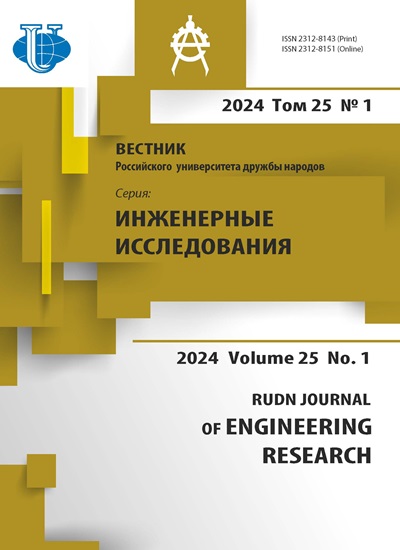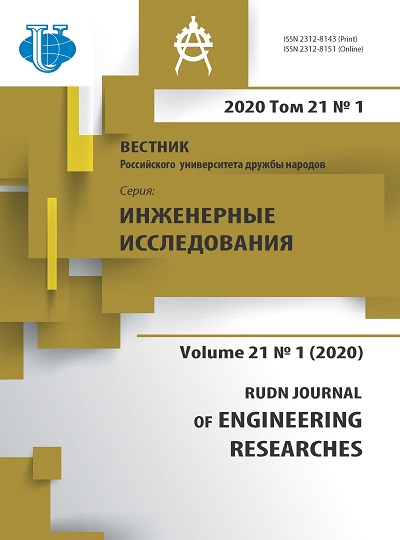Topological optimization of the “Earring” element
- Authors: Kamardina N.V.1, Guseynov R.M.1, Danilov I.K.1, Konoplev V.N.1, Ivanov K.A.1, Zharko A.S.1, Polishchuk G.M.1
-
Affiliations:
- Peoples’ Friendship University of Russia (RUDN University)
- Issue: Vol 21, No 1 (2020)
- Pages: 20-26
- Section: Mechanical engineering and machine science
- URL: https://journals.rudn.ru/engineering-researches/article/view/24649
- DOI: https://doi.org/10.22363/2312-8143-2020-21-1-20-26
Cite item
Full Text
Abstract
In recent decades, computer technologies and software such as computer-aided design (CAD) have been actively developing. Thanks to this, modern machine-building enterprises increase the reliability and quality of their products while reducing their weight and complexity of manufacturing. In order to meet numerous requirements, leading companies are increasingly using topological optimization tools at various design stages. The use of this method for effective product design is growing rapidly, due to the continuously increasing computing power of computers and software capabilities. Modern software for topological optimization allows to design the shape of the part from scratch, setting only the conditions for fixing and touching surfaces, and also allows to improve existing structures by reducing their weight based on the set restrictions (equal strength with the original part, equal deformation, preservation of natural frequency, etc.). However, the result of topological optimization is often a complex spatial structure. Using the example of the “Earring” element, a topological optimization of the structure was performed to ensure that the strength requirements were met and that the minimum mass was obtained. As a result of optimization, the design of a reduced weight compared to the prototype is obtained. The results of the verification calculation showed the sufficiency of the values of the strength reserves of the final design of the “Earring”.
About the authors
Natalia V. Kamardina
Peoples’ Friendship University of Russia (RUDN University)
Author for correspondence.
Email: 1032142655@rudn.ru
student of the Department of Mechanical Engineering and Instrumentation of Engineering Academy of RUDN University
6 Miklukho-Maklaya St, Moscow, 117198, Russian FederationRuslan M. Guseynov
Peoples’ Friendship University of Russia (RUDN University)
Email: engj@rudn.ru
postgraduate student of the Department of Mechanical Engineering and Instrumentation of Engineering Academy of RUDN University
6 Miklukho-Maklaya St, Moscow, 117198, Russian FederationIgor K. Danilov
Peoples’ Friendship University of Russia (RUDN University)
Email: engj@rudn.ru
Professor of the Department of Mechanical Engineering and Instrumentation of Engineering Academy of RUDN University, Doctor of Technical Sciences, Professor
6 Miklukho-Maklaya St, Moscow, 117198, Russian FederationVladimir N. Konoplev
Peoples’ Friendship University of Russia (RUDN University)
Email: engj@rudn.ru
Associate Professor of the Department of Mechanical Engineering and Instrumentation of Engineering Academy of RUDN University, Doctor of Technical Sciences, Associate Professor
6 Miklukho-Maklaya St, Moscow, 117198, Russian FederationKirill A. Ivanov
Peoples’ Friendship University of Russia (RUDN University)
Email: engj@rudn.ru
student of the Department of Mechanical Engineering and Instrumentation of Engineering Academy of RUDN University
6 Miklukho-Maklaya St, Moscow, 117198, Russian FederationAndrey S. Zharko
Peoples’ Friendship University of Russia (RUDN University)
Email: engj@rudn.ru
student of the Department of Mechanical Engineering and Instrumentation of Engineering Academy of RUDN University
6 Miklukho-Maklaya St, Moscow, 117198, Russian FederationGeorgy M. Polishchuk
Peoples’ Friendship University of Russia (RUDN University)
Email: engj@rudn.ru
Professor of the Department of Mechanics and Mechatronics of Engineering Academy of RUDN University, Doctor of Technical Sciences, Professor
6 Miklukho-Maklaya St, Moscow, 117198, Russian FederationReferences
- Popova DD, Samoilenko NA, Semenov SV, Balakirev AA, Golovkin AYu. Primenenie metoda topologicheskoi optimizatsii dlya umen'sheniya massy konstruktivno podobnogo kronshteina truboprovoda aviatsionnogo GTD [Pipeline aviation gas turbine engine]. Vestnik PNIPU. Aerokosmicheskaya tekhnika [Bulletin of PNIPU. Aerospace Engineering]. 2018;(55–1):42–51. (In Russ.)
- Vasiliev BE, Maharramov LA. Analiz vozmozhnosti primeneniya topologicheskoi optimizatsii pri proektirovanii neokhlazhdaemykh rabochikh lopatok turbin [Analysis of the possibilities of applying topological optimization in the design of uncooled turbine blades]. Vestnik Samarskogo gosudarstvennogo aerokosmicheskogo universiteta [Bulletin of the Samara State Aerospace University]. 2015;14(3–1): 139–147. (In Russ.)
- Bendsoy MP, Sigmund O. Optimization of topology: theory, methods and applications. Springer Verlag; 2003. p. 370–375.
- Borovikov AA, Tenenbaum SM. Topologicheskaya optimizatsiya perekhodnogo otseka KA [Topological optimization of the spacecraft transition compartment]. Aerokosmicheskii nauchnyi zhurnal [Aerospace Scientific Journal]. 2016;(5):16–30. (In Russ.)
- Frantsuzov AV, Shapovalov YI, Vdovin DS. Primenenie metoda topologicheskoi optimizatsii v zadachakh proektirovaniya gruzopod"emnoi tekhniki [Application of the method of topological optimization in the problems of designing lifting equipment]. Izvestiya vuzov. Povolzhskii region. Tekhnicheskie nauki [News of universities. Volga region. Technical science]. 2017;2(42):99–108. (In Russ.)
- Shestakov D. Primenenie Generative Design dlya optimizatsii konstruktsii kronshteina aviadvigatelya [Application of Generative Design to optimize the design of the aircraft engine bracket]. Additivnye tekhnologii [Additive technologies]. Available from: https://additiv-tech.ru/ publications/primenenie-generative-design-dlya-optimizaciikonstrukcii-kronshteyna-aviadvigatelya (accessed: June 12, 2019). (In Russ.)
- Bashin KA, Torsunov RA, Semenov SV. Metody topologicheskoi optimizatsii konstruktsii, primenyayushchiesya v aerokosmicheskoi otrasli [Methods of topological optimization of structures used in the aerospace industry]. Vestnik Permskogo natsional'nogo issledovatel'skogo politekhnicheskogo universiteta. Aerokosmicheskaya tekhnika [Bulletin of the Perm National Research Polytechnic University. Aerospace Engineering]. 2017;(51):51–61. (In Russ.)
- Krotkikh AA, Maksimov PV. Issledovanie i modifikatsiya metoda topologicheskoi optimizatsii SIMP [Research and modification of parameters of topological optimization SIMP]. Mezhdunarodnyi nauchno-issledovatel'skii zhurnal [International Scientific Researcher Journal]. 2016; 1(55):91–94. (In Russ.)
- Bruns T. A reevaluation of the SIMP method with filtering and an alternative formulation for solid – void topology optimization. Structural and interdisciplinary optimization. 2005;30:428–436.
- Jiao H, Zhou Q, Fan S, Li Yu. A new hybrid methodology for optimizing topology, combining the ESO and SIMP method. Lecture Notes in Electrical Engineering Proceedings of China. Modern Logistics Engineering; 2014. p. 373–384.
- Sigmund O, Maut K. Optimization of the structure topology approaches: a comparative review. Structural and interdisciplinary optimization. 2013;48:1031–1055.
- Koga J, Koga J, Homma S. The task of a chessboard to optimize the topology of continuum structures. Saitama, Japan: University of Saitama; 2013. p. 10–15.
- Prodways Group. Availabe from: https://www. prodways.com (accessed: March 21, 2020).
- Ansys. Available from: https://www.ansys.com (accessed: March 28, 2020).
- Maksimov PV, Fetisov KV. Analiz metodov dorabotki konechno-elementnoi modeli posle topologicheskoi optimizatsii [Analysis of the methods of refinement of the finite element model after topological optimization]. Mezhdunarodnyi nauchno-issledovatel'skii zhurnal [International Scientific Researcher Journal]. 2016;9(51–2): 58–60. (In Russ.)
















